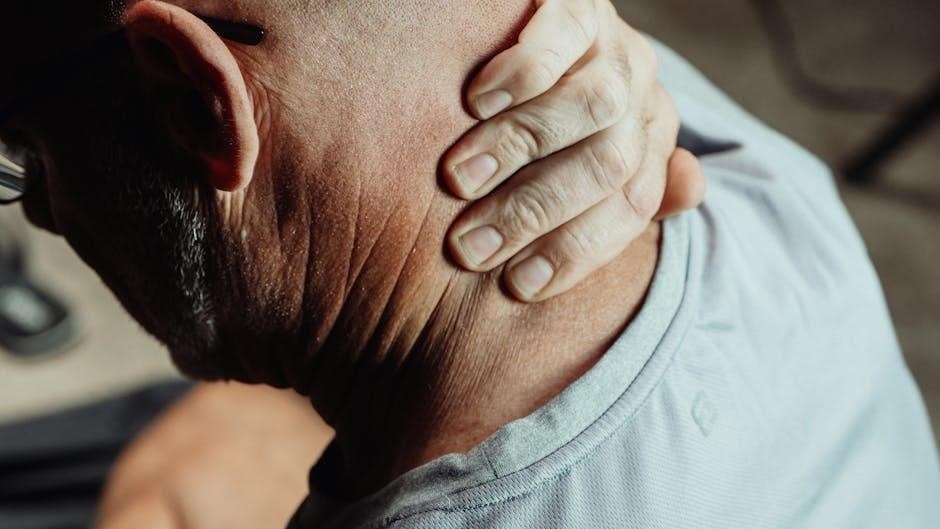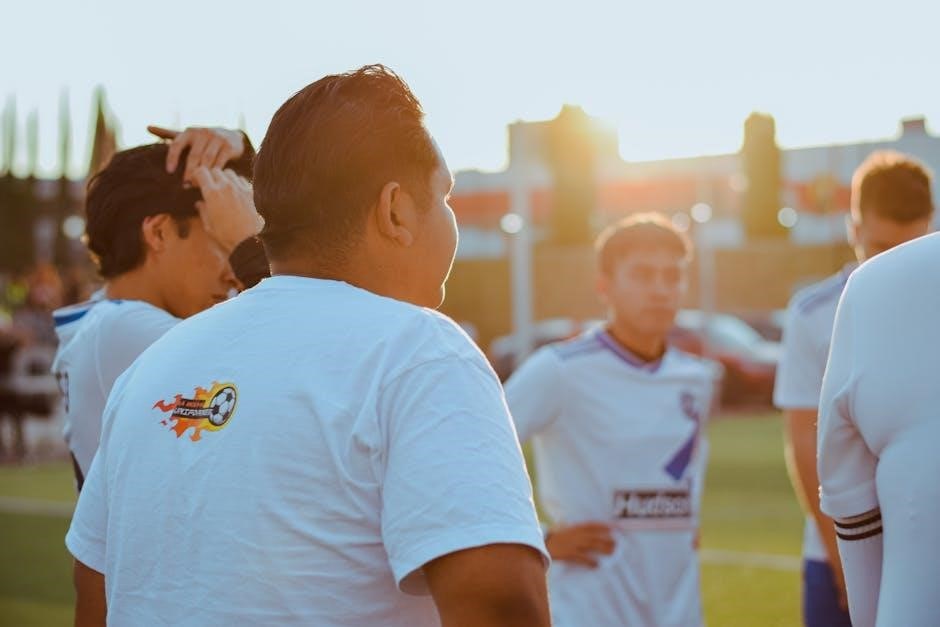Download a comprehensive PDF guide to hip ORIF physical therapy protocols. Learn about exercises‚ timelines‚ and tips for a smooth recovery after hip open reduction internal fixation (ORIF) surgery. Get instructions for home exercises and precautions.
What is a Hip Fracture?
A hip fracture is a break that occurs in the upper quarter of the femur‚ also known as the thigh bone. The hip joint itself is a ball-and-socket joint‚ which allows the upper leg to bend and rotate at the pelvis. It’s important to note that an injury specifically to the acetabulum‚ which is the socket part of the hip joint‚ is generally not considered a hip fracture.
Hip fractures can significantly impact mobility and require prompt medical attention‚ often involving surgical intervention like ORIF (Open Reduction Internal Fixation) to stabilize the bone. Recovery usually involves a structured physical therapy program to restore strength‚ range of motion‚ and function. Understanding the nature of a hip fracture is crucial for effective treatment and rehabilitation.
Surgical Procedure: Open Reduction Internal Fixation (ORIF)
Open Reduction Internal Fixation‚ commonly known as ORIF‚ is a surgical procedure performed to repair a hip fracture. It is crucial that the ORIF procedure is carried out as soon as possible after the injury‚ preferably within 24 to 48 hours. This prompt action is vital to prevent any disruption of the vulnerable blood supply to the femoral head‚ which can lead to complications.
The procedure involves “open reduction‚” meaning the fractured bone fragments are surgically realigned into their correct anatomical position. “Internal fixation” then involves using hardware like plates‚ screws‚ rods‚ or wires to hold the bones together while they heal. The specific type of fixation used depends on the fracture pattern and the surgeon’s preference. The goal of ORIF is to stabilize the fracture‚ relieve pain‚ and allow for early mobilization and rehabilitation.
Timing of ORIF Surgery
The timing of Open Reduction Internal Fixation (ORIF) surgery for a hip fracture is a critical factor influencing the patient’s recovery and overall outcome. Ideally‚ ORIF should be performed as soon as possible after the injury occurs‚ typically within 24 to 48 hours. This prompt surgical intervention is essential for several reasons.
Firstly‚ it minimizes the risk of disrupting the blood supply to the femoral head‚ which is particularly vulnerable after a hip fracture. Delaying surgery can compromise blood flow‚ potentially leading to avascular necrosis‚ a condition where the bone tissue dies due to lack of blood. Secondly‚ early ORIF allows for earlier mobilization and weight-bearing‚ which helps to prevent complications associated with prolonged immobility‚ such as blood clots‚ muscle weakness‚ and pressure sores. Faster surgery may lead to shorter hospital stays.
Femoral Neck Pinning
Femoral neck pinning is a surgical technique used to stabilize and fix fractures of the femoral neck‚ which is the region of the femur located just below the ball of the hip joint. This procedure involves placing multiple screws‚ typically two or three‚ across the fracture line in the femoral neck. The screws compress the fracture fragments together‚ promoting bone healing and stability.
Femoral neck pinning is often preferred for non-displaced or minimally displaced femoral neck fractures‚ where the bone fragments are still relatively aligned. The goal of this procedure is to achieve stable fixation while preserving the patient’s natural hip joint. Early mobilization and weight-bearing are often possible after femoral neck pinning‚ which can help to expedite the patient’s recovery and rehabilitation. The specific approach and number of screws used may vary depending on the fracture pattern and the surgeon’s preference.

Post-operative Rehabilitation Protocol
This protocol outlines a phase-based rehabilitation process after hip ORIF. It includes early mobilization‚ weight-bearing guidelines‚ home exercises‚ and pain management strategies to help patients regain function and independence after surgery.
Phases of Rehabilitation
Post-operative rehabilitation following hip ORIF typically progresses through distinct phases‚ each with specific goals and exercises. Phase I focuses on immobilization and early pain management‚ gradually introducing gentle range of motion exercises. Weight-bearing is often restricted initially‚ with progression guided by pain levels and healing progress.

Phase II emphasizes regaining range of motion‚ improving muscle strength‚ and initiating functional activities. As healing advances‚ Phase III involves progressive strengthening exercises‚ balance training‚ and a gradual return to more demanding activities;
The final phase focuses on achieving full functional recovery‚ optimizing strength and endurance‚ and returning to pre-injury activity levels‚ all while adhering to precautions to protect the healing hip. The therapist may modify the program appropriately depending on the individuals goals.
Early Mobilization and Weight Bearing
Early mobilization is crucial after hip ORIF surgery to prevent complications and promote healing. Physical therapy typically begins the day of surgery‚ focusing on gentle range of motion exercises and bed mobility. Standing practice with a walker is initiated‚ gradually increasing distance and intervals.
Weight-bearing progression is criterion-based and varies depending on individual factors and the surgeon’s protocol. Partial weight-bearing is often allowed initially‚ gradually increasing to full weight-bearing as tolerated.
Adherence to the prescribed weight-bearing status is essential to protect the healing bone. Ambulation with physical therapy occurs multiple times daily. The therapist monitors progress and adjusts the program accordingly. Always follow the method taught by your physiotherapist when moving in and out of bed.
Home Exercise Program
A home exercise program is a vital component of rehabilitation after hip ORIF surgery. It complements physical therapy sessions and helps maintain progress. The program typically includes exercises to improve range of motion‚ strength‚ and balance. It should be followed 2-3 times per day.
Common exercises include ankle pumps (pointing the foot down and pulling it up)‚ heel slides‚ and gentle hip abduction (moving the leg away from the body). Remember to take your pain medication at least ½ hour prior to exercising.
It’s crucial to follow the specific instructions provided by your physical therapist‚ paying attention to proper form and avoiding overexertion. The program is tailored to individual needs and weight-bearing status. Consistency with the home exercise program is essential for optimal recovery.
Importance of Pain Management
Effective pain management is crucial after hip ORIF surgery for successful rehabilitation. Pain can hinder participation in physical therapy‚ slow down recovery‚ and negatively impact overall well-being. Adequate pain control allows patients to engage more fully in exercises and activities‚ leading to improved outcomes.
Pain management strategies may include medication‚ such as analgesics prescribed by your doctor. The method taught by your physiotherapist when moving is also important. It’s also important to take your pain medication at least ½ hour prior to exercising.
Open communication with your medical team about pain levels and any side effects from medication is essential. Addressing pain effectively can optimize the rehabilitation process and facilitate a faster return to function. Remember that pain management is a collaborative effort involving the patient‚ physicians‚ and physical therapists.

Physical Therapy Exercises
Physical therapy exercises are vital after hip ORIF to regain strength and mobility. These exercises focus on restoring range of motion‚ improving muscle strength‚ and enhancing balance for a return to daily activities and function.
Types of Exercises
Following a hip ORIF‚ a variety of exercises are crucial for rehabilitation. These typically begin with gentle range-of-motion exercises to prevent stiffness and improve joint mobility. Ankle pumps‚ heel slides‚ and gentle hip rotations are common starting points. As healing progresses‚ strengthening exercises are introduced‚ targeting the muscles around the hip‚ including the glutes‚ quads‚ and hamstrings.
Isometric exercises‚ where muscles are contracted without movement‚ can be used early on to activate muscles without stressing the healing bone. Weight-bearing exercises‚ gradually increasing from partial to full weight-bearing‚ are essential for restoring normal walking patterns. Balance exercises are also incorporated to improve stability and prevent falls. Each exercise should be performed under the guidance of a physical therapist.
They will tailor the program to individual needs and progress‚ ensuring proper form and preventing complications. The goal is to progressively challenge the hip while respecting pain levels and promoting optimal healing.
Frequency and Duration of Exercises
The frequency and duration of exercises following hip ORIF surgery are crucial elements in a successful rehabilitation program. Typically‚ a home exercise program should be followed 2-3 times per day to maintain joint mobility and muscle strength. Each exercise session may last around 20-30 minutes‚ but this can vary depending on individual tolerance and the specific exercises prescribed by the physical therapist.
In the early stages‚ shorter‚ more frequent sessions may be recommended to avoid overexertion and manage pain. As strength and endurance improve‚ the duration of each session can be gradually increased. It’s essential to listen to your body and avoid pushing through pain‚ as this can hinder healing and lead to complications.
Consistency is key‚ so adhering to the prescribed frequency and duration‚ while respecting pain limits‚ will optimize recovery and functional outcomes. Regular communication with the physical therapist is vital to adjust the exercise plan as needed.

Precautions After Hip ORIF Surgery
Following hip ORIF surgery‚ adhering to specific precautions is paramount for preventing complications and ensuring proper healing. One of the primary precautions involves weight-bearing restrictions‚ as advised by the surgeon and physical therapist. Avoid activities that place excessive stress on the operated hip‚ such as lifting heavy objects or engaging in high-impact exercises‚ until cleared.
Movement restrictions are also crucial‚ including avoiding excessive hip flexion‚ adduction‚ and internal rotation‚ as these motions can compromise the stability of the surgical fixation. Use assistive devices like walkers or crutches as instructed to maintain balance and reduce the risk of falls. Modify your home environment to remove tripping hazards and ensure easy access to frequently used items.
Monitor for signs of infection‚ such as increased pain‚ swelling‚ redness‚ or drainage at the incision site‚ and report any concerns to your healthcare provider promptly. By diligently following these precautions‚ you can optimize your recovery and minimize the risk of setbacks after hip ORIF surgery.



